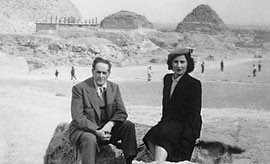The antiquities collected by the Diniacopoulos family have a long history in Quebec, from Vincent and Olga Diniacopoulos’ arrival in Montreal in 1951 with crates of artifacts to their subsequent acquisitions and exhibitions at several venues around the city; to the eventual deposition of a portion of their collection in the National Museum of Fine Arts of Quebec nearly a half-century later. The passing of Mrs. Diniacopoulos encouraged renewed interest in the collection, prompted in part by the family’s bequest of scholarship money to Concordia University, where their son, Denis, had long been a faculty member. This university, where the family’s archives are now housed, has been celebrating the legacy of the Diniacopoulos family and their relationship with Concordia through several academic projects focusing on their antiquities collection. In 2004, a collaborative effort between Concordia’s Office of the President, the Classics Section, and the Montreal Museum of Fine Arts produced a two-day conference and publication, edited by J.M. Fossey and J.E. Francis that presented various aspects of the Greek and Roman artifacts. In 2011, Concordia University published a similar volume highlighting the Diniacopoulos family’s Egyptian collection, edited by J.E. Francis and G.W.M. Harrison.
The artifacts in the Diniacopoulos collection represent only a portion of their original holdings, but they nonetheless show wide geographical and chronological spans. Material from ancient cultures of the central and western Mediterranean--Egypt and Syria to Greece, Italy, and Cyprus—date from the Late Bronze Age through the Late Roman period of the 3rd-4th centuries C.E. Artifact types include Greek vases and iconography, Greek, Roman, and Egyptian sculpture, Greek epigraphy, and the minor arts, such as terracotta figurines, small-scale bronzes, and glass.


 Vincent and Olga Diniacopoulos in Egypt
Vincent and Olga Diniacopoulos in Egypt